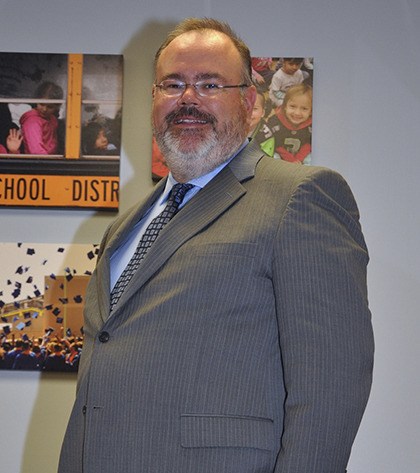Editor’s note: This is the final installent in a two-part series on Auburn School District’s Alan Spicciati as he reflects on his first year as superintendent. In this piece, Spicciati looks ahead to areas of focus for the upcoming school year.
Whenever he looks at his agenda for the upcoming school year, Auburn School District Superintendent Alan Spicciati has a critical date in mind — Nov. 8.
That’s the day local voters determine whether to pass a capital facilities bond that would replace six schools and build two new ones.
“There won’t be anything more important for the next several months than getting the word out and helping our community understand the need, and why the district has put this bond on the November ballot,” Spicciati said. “Our job is to inform the community, make them understand what the challenges are and what the need is. We have an important story to tell to get the word out.”
Cindi Blansfield, the district’s assistant superintendent for business and operations, said the school board has accepted the recommendations of its more than 60-member ad hoc committee to replace five elementary schools built between 1945 and 1965 – Terminal Park, Dick Scobee, Pioneer, Chinook and Lea Hill – and Olympic Middle School. The latter building opened in 1957. Spicciati said those facilities face challenges as the district moves toward its goal of providing each student with one technological device —such as a Chromebook — in the coming years. In 2014, the district passed a $22 million technology capital projects levy.
“I look at my own kids and what they do at 13 and 15 years old,” Spicciati said. “The world they’re living in does not reflect the schools before technology. If we want to remain relevant, especially to our older kids, we have to use the tools they use all day outside of school.”
In addition to those issues, Spicciati said, ASD’s older schools are not only more difficult to secure but were also built to outdated seismic standards.
As for the addition of two new elementary schools, he said, the district’s ad hoc committee recommended that, too. Spicciati said the district has added more than 1,000 students since the last new elementary school, Arthur Jacobsen, opened in 2007.
“And we have another 1,000 or so coming in the near future,” he said. “It’s a critical need, as well as replacing schools.”
While the $456 million levy, which would add an estimated $1.03 per $1,000 of assessed property value, is at the forefront, it is not the only issue on which Spicciati has riveted his attention.He said he would like to focus on the performance of ASD students after they graduate, regardless of whether they head to college or pursue a career.
“I think, in general, that K-12 education forgets about career at times,” Spicciati said. “We actually have some very strong CTE programs to build on, but we want to connect our students beyond high school into other technical programs or career pathways to help our students get jobs where they can support their family and come back and contribute to the community.”
He said about 60 percent of the district’s students advance to two- and four-year colleges after graduation, which is close to the state average. In order to improve upon that, Spicciati said he would like to build a “pathway program” where students can earn two- and four-year degrees from Green River College while they are in high school.
“I’m hoping to strengthen our relationship with Green River College,” he said. “It’s such an asset right in our backyard.
“We need to be responsive so that we’re giving kids a head start who may not have some of the resources to go straight through a four-year college.”
But Spicciati also recognizes that not all students are interested in attending college, and he wants to help them find ways to be successful, as well. He said one example of an alternative path is provided by Boeing, which he said wants to hire 150 students each year out of high school.
“That’s an example of a pathway for a student to earn a good wage and to have a job that provides training and education benefits,” Spicciati said. “We actually have some strong (Career Technical Education) programs to build on, but we want to connect our students beyond high school into other technical programs or career pathways to help our students get jobs where they can support their families.”



